Effect of sPP Content on Electrical Tree Growth Characteristics in PP-Blended Cable Insulation
Abstract
1. Introduction
2. Experimental Arrangement
2.1. Sample Preparation and Characteristics
2.2. Electrical Treeing and Breakdown Tests
2.3. Trap Level Distribution Characterized by IDC Test
3. Results
3.1. Effect of sPP Content on Electrical Tree Inception
3.2. Effect of sPP Content on Electrical Tree Morphologies
3.3. Relationship between Electrical Tree Morphologies and Propagation
3.4. Effect of sPP Content on AC Breakdown Strength
4. Discussion
4.1. Effects of sPP Content on Crystallization
4.2. Effects of Crystallization on Electrical Tree Growth under AC Stress
5. Conclusions
- (1)
- With the incorporation of sPP increasing to 15 wt%, the inception time of electrical tree increases by 8.2%. The addition of sPP by 15% distinguishes an excellent performance in inhibiting electrical treeing, which benefits from the ability to promote the fractal dimension and lateral growth of branches at 50 and 70 °C. When the temperature rises to 90 °C, the blends with 5 wt% sPP exhibits a better inhibition of the electrical tree than that of 15 wt%.
- (2)
- With the rise of the sPP content from 0 to 15 wt%, the incorporation of sPP improves the crystallinity of polypropylene matrix and promotes heterogeneous nucleation of crystallization. Increase of crystallinity and heterogeneous nucleation introduce a large number of interfaces of crystal region and amorphous region.
- (3)
- The introduced interface regions contain deep traps and form a space charge electric field, restraining the further injection of charges, thus inhibiting the propagation of the electrical tree. It is concluded that a 15 wt% addition of sPP exhibits a great potential application in AC cable insulation.
Author Contributions
Funding
Conflicts of Interest
References
- Andritsch, T.; Vaughan, A.; Stevens, G.C. Novel insulation materials for high voltage cable systems. IEEE Electr. Insul. Mag. 2017, 33, 27–33. [Google Scholar] [CrossRef]
- Huang, X.; Zhang, J.; Jiang, P.; Tanaka, T. Material progress toward recyclable insulation of power cables part 2: Polypropylene-based thermoplastic materials. IEEE Electr. Insul. Mag. 2019, 36, 8–18. [Google Scholar] [CrossRef]
- Kurahashi, K.; Matsuda, Y.; Ueda, A.; Demura, T.; Miyashita, Y.; Yoshino, K. The application of novel polypropylene to the insulation of electric power cable. IEEE/PES Transm. Distrib. Conf. Exhib. 2003, 1278–1283. [Google Scholar] [CrossRef]
- Liu, W.; Cheng, L.; Li, S. Review of electrical properties for polypropylene based nanocomposite. Compos. Commun. 2018, 10, 221–225. [Google Scholar] [CrossRef]
- Zhu, L.W.; Du, B.X.; Su, J.G. Electrical treeing initiation and breakdown phenomenon in polypropylene under DC and impulse combined voltages. IEEE Trans. Dielectr. Electr. Insul. 2019, 26, 26202–26210. [Google Scholar] [CrossRef]
- Du, B.X.; Zhu, L.W.; Han, T. Effect of ambient temperature on electrical treeing and breakdown phenomenon of polypropylene with repetitive pulse voltage. IEEE Trans. Dielectr. Electr. Insul. 2017, 24, 2216–2224. [Google Scholar] [CrossRef]
- Yuan, H.; Zhou, Y.; Zhu, Y.J. Origins and effects of deep traps in functional group grafted polymeric dielectric materials. J. Phys. D Appl. Phys. 2020, 53, 475301. [Google Scholar] [CrossRef]
- Zhou, Y.; Hu, J.; Dang, B.; He, J. Effect of different nanoparticles on tuning electrical properties of polypropylene nanocomposites. IEEE Trans. Dielectr. Electr. Insul. 2017, 24, 1380–1389. [Google Scholar] [CrossRef]
- Cao, W.; Li, Z.; Sheng, G.; Jiang, X. Insulating property of polypropylene nanocomposites filled with nano-MgO of different concentration. IEEE Trans. Dielectr. Electr. Insul. 2017, 24, 1430–1437. [Google Scholar] [CrossRef]
- Cheng, L.; Chi, X.; Yan, C. Polypropylene nanocomposite for power equipment: A review. IET Nanodielectr. 2018, 1, 92–103. [Google Scholar] [CrossRef]
- Hosier, I.; Vaughan, A.S.; Swingler, S.G. An investigation of the potential of polypropylene and its blends for use in recyclable high voltage cable insulation systems. J. Mater. Sci. 2011, 46, 4058–4070. [Google Scholar] [CrossRef]
- Zhang, X.Q.; Zhao, Y.; Wang, Z.G. Morphology and mechanical behavior of isotactic polypropylene (iPP)/syndiotactic polypropylene (sPP) blends and fibers. Polymer 2005, 46, 5956–5965. [Google Scholar] [CrossRef]
- Du, B.; Zhong, Z.; Du, B. Dielectric relaxation and trap-modulated DC breakdown of polypropylene blend insulation. Polymer 2019, 185, 121935. [Google Scholar] [CrossRef]
- Du, B.; Fan, M.; Zhong, Z.; Du, B. Coupling Effect of Molecular Chain Displacement and Carrier Trap Characteristics on DC Breakdown of HDPE/LDPE Blend Insulation. Polymer 2020, 12, 589. [Google Scholar] [CrossRef]
- Thomann, R.; Kressler, J.; Setz, S. Morphology and phase behaviour of blends of syndiotactic and isotactic polypropylene. Polymer 1996, 37, 2627–2634. [Google Scholar] [CrossRef]
- Maier, R.-D.; Thomann, R.; Rudolf, B. The influence of stereoregularity on the miscibility of poly(propylene)s. J. Polym. Sci. Part B Polym. Phys. 1997, 35, 1135–1144. [Google Scholar] [CrossRef]
- Woo, E.M.; Cheng, K.Y.; Chen, Y. Experimental verification on UCST phase diagrams and miscibility in binary blends of isotactic, syndiotactic, and atactic polypropylenes. Polymer 2007, 48, 5753–5766. [Google Scholar] [CrossRef]
- Zou, X.X.; Yang, W.; Zheng, G.Q. Crystallization and phase morphology of injection-molded isotactic polypropylene (iPP)/syndiotactic polypropylene (sPP) blends. J. Polym. Sci. Part B Polym. Phys. 2007, 45, 2948–2955. [Google Scholar] [CrossRef]
- Bourbigot, S.; Ganier, L.; Duquesne, S. Characterization of the morphology of iPP/sPP blends with various compositions. Express Polym. Lett. 2013, 7, 224–237. [Google Scholar] [CrossRef]
- Kudo, K. Fractal analysis of electrical trees. IEEE Trans. Dielectr. Electr. Insul. 1998, 5, 713–727. [Google Scholar] [CrossRef]
- Du, B.X.; Hou, Z.H.; Li, J.; Li, Z.L. Effect of graphene nanoplatelets on space charge and breakdown strength of PP/ULDPE blends for HVDC cable insulation. IEEE Trans. Dielectr. Electr. Insul. 2018, 25, 2405–2412. [Google Scholar] [CrossRef]
- Simmons, J.G.; Tam, M.C. Theory of Isothermal Currents and the Direct Determination of Trap Parameters in Semiconductors and Insulators Containing Arbitrary Trap Distributions. Phys. Rev. B 1973, 7, 3706–3713. [Google Scholar] [CrossRef]
- Li, Z.; Zhou, S.; Du, B. Effect of Crystalline Morphology on Electrical Tree Growth Characteristics of High-density and Low-density Polyethylene Blend Insulation. IEEE Access 2020, 8, 1. [Google Scholar] [CrossRef]
- Jeziorny, A. Parameters characterizing the kinetics of the non-isothermal crystallization of poly (ethylene terephthalate) determined by d.s.c. Polymer 1978, 19, 1142–1144. [Google Scholar] [CrossRef]
- Shi, Z.; Zhang, X.; Wang, K.; Gao, J.; Guo, N. Investigation on electrical tree propagation in polyethylene based on etching method. AIP Adv. 2017, 7, 115012. [Google Scholar] [CrossRef]
- Teyssedre, G.; Laurent, C. Charge transport modeling in insulating polymers: From molecular to macroscopic scale. IEEE Trans. Dielectr. Electr. Insul. 2005, 12, 857–875. [Google Scholar] [CrossRef]
- Vaughan, A.S.; Hosier, I.L.; Dodd, S.J.; Sutton, S.J. On the structure and chemistry of electrical trees in polyethylene. J. Phys. D Appl. Phys. 2006, 39, 962–978. [Google Scholar] [CrossRef]
- Kao, K.C. New theory of electrical discharge and breakdown in low-mobility condensed insulators. J. Appl. Phys. 1984, 55, 752–755. [Google Scholar] [CrossRef]
- Alapati, S.; Meledath, J.T.; Karmarkar, A. Effect of morphology on electrical treeing in low density polyethylene nanocomposites. IET Sci. Meas. Technol. 2014, 8, 60–68. [Google Scholar] [CrossRef]
- Yan, Z.; Yang, K.; Wang, S.; Zou, Y.; Li, J.; Yang, F. Electrical tree in silicone rubber: Roles of silicone grease and switching impulses. IEEE Trans. Dielectr. Electr. Insul. 2020, 27, 829–836. [Google Scholar] [CrossRef]
- Yang, K.; Liu, Y.; Yan, Z.M. Enhanced Morphology-Dependent Tensile Property and Breakdown Strength of Impact Polypropylene Copolymer for Cable Insulation. Materials 2020, 13, 3935. [Google Scholar] [CrossRef] [PubMed]
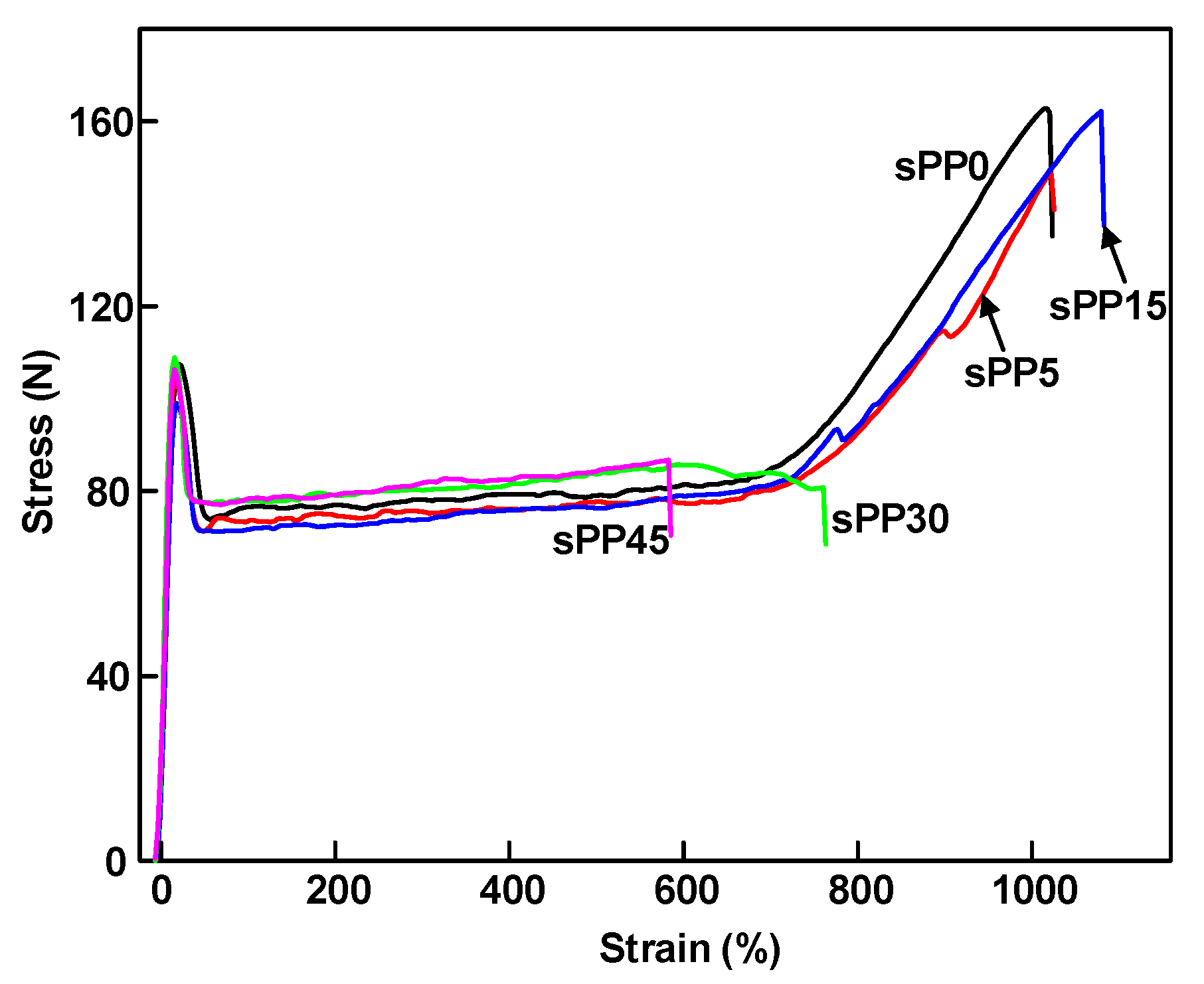
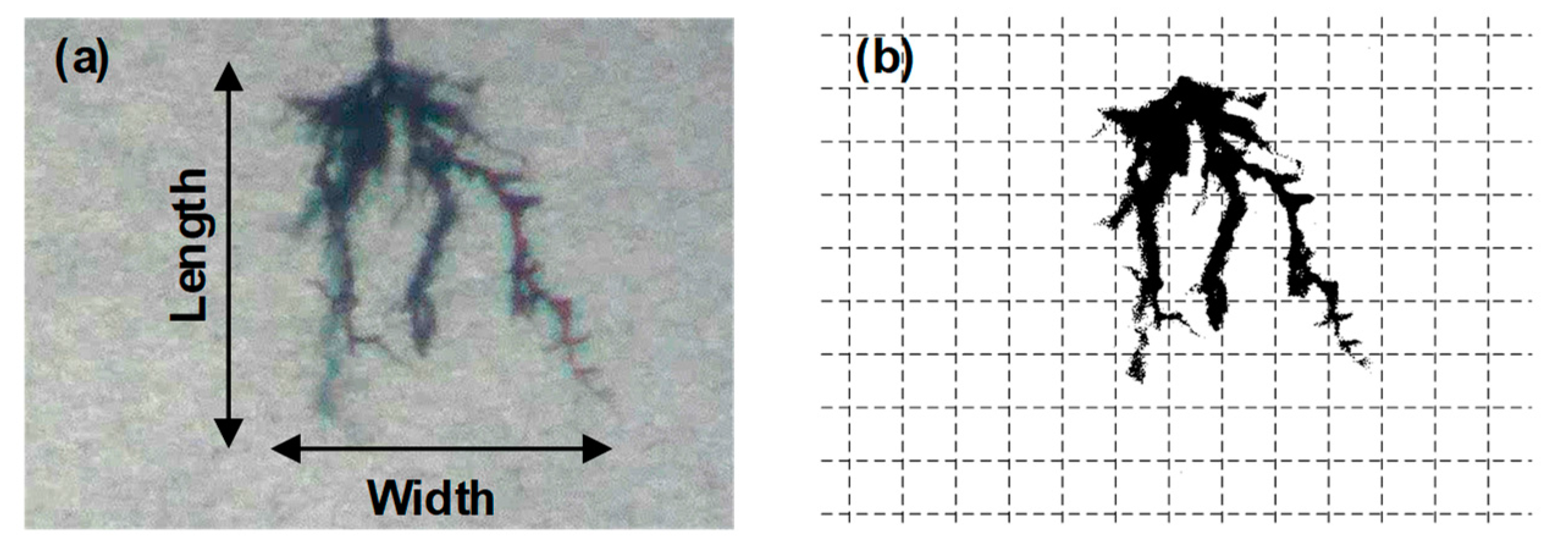
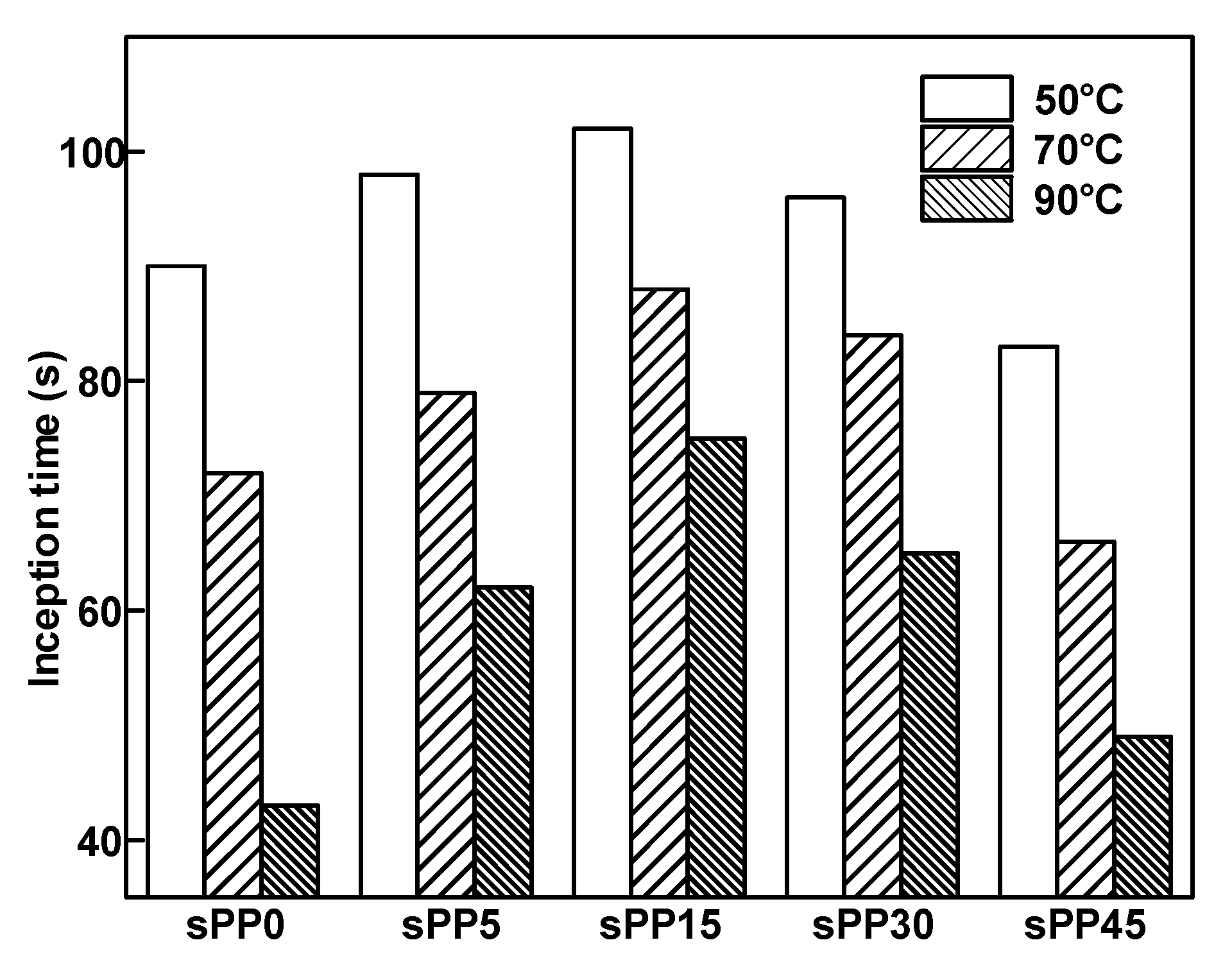
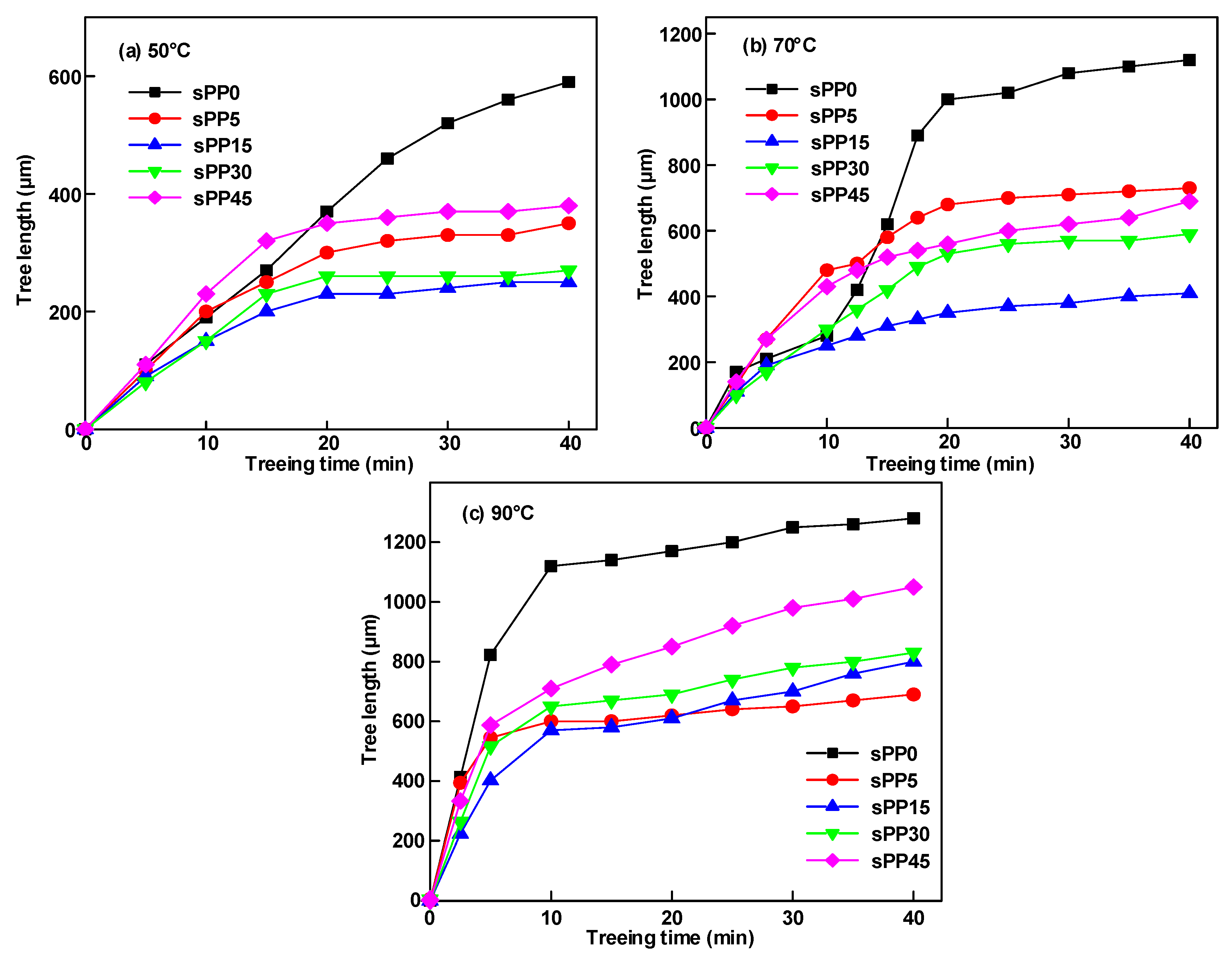

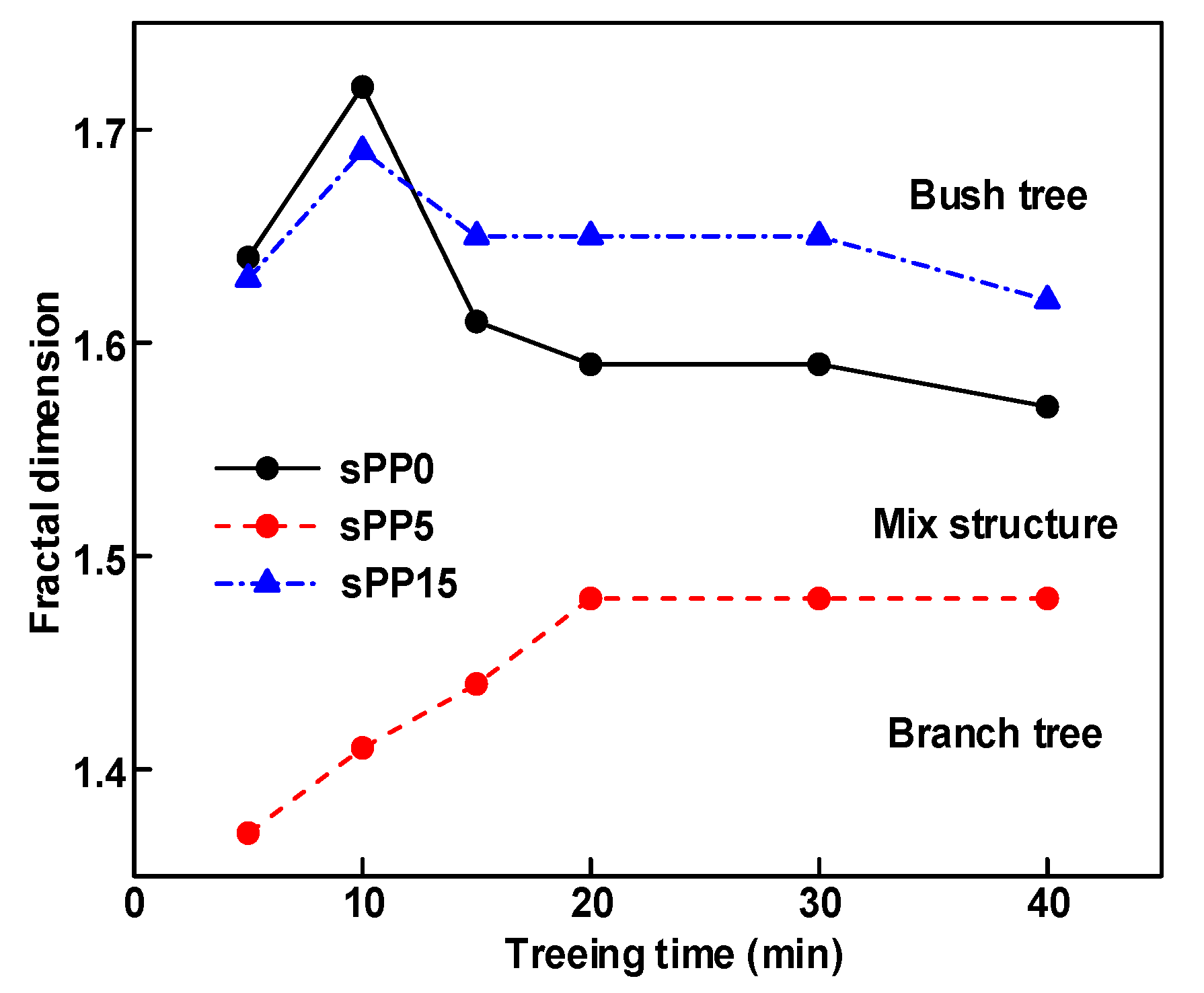

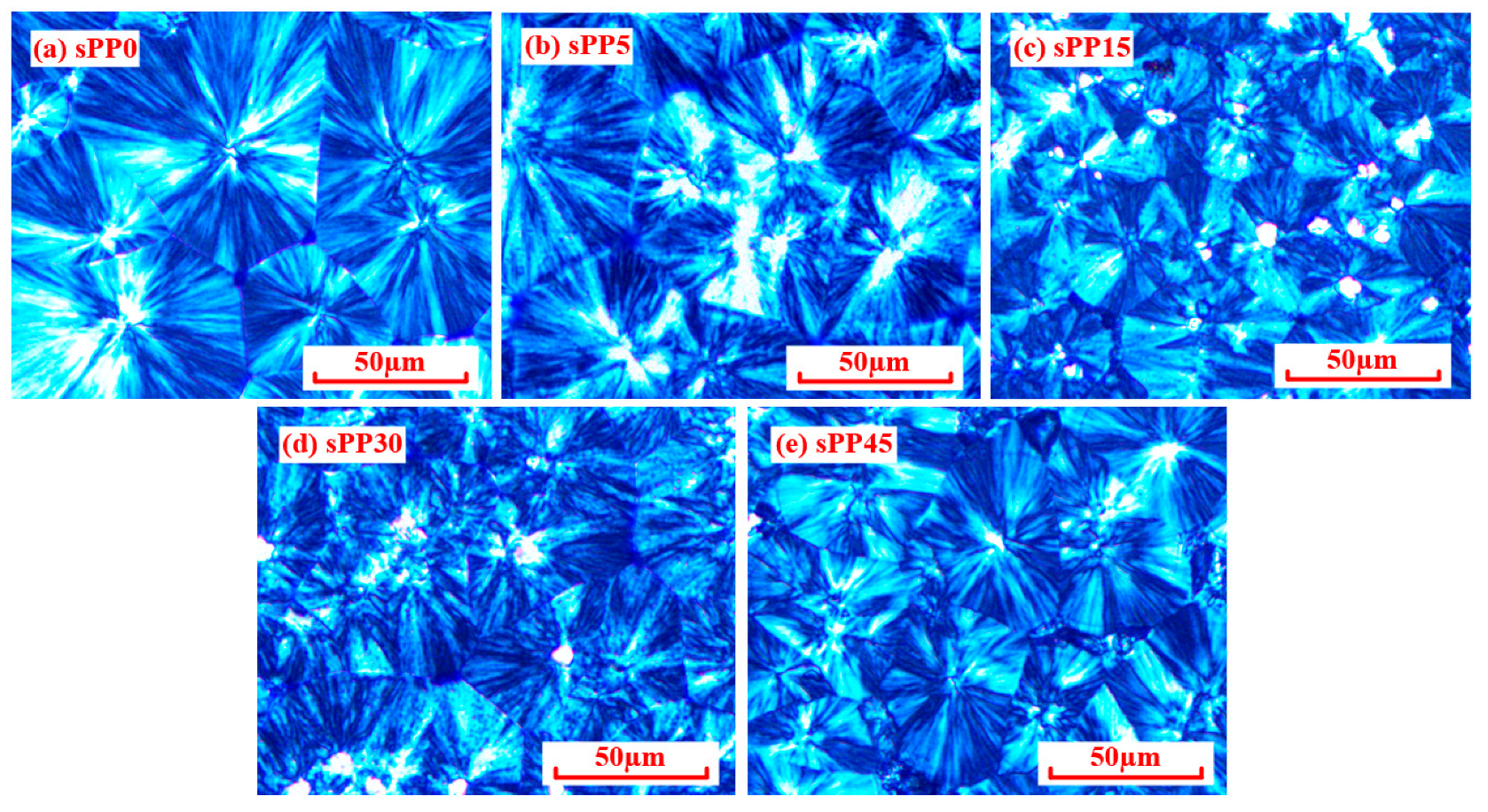
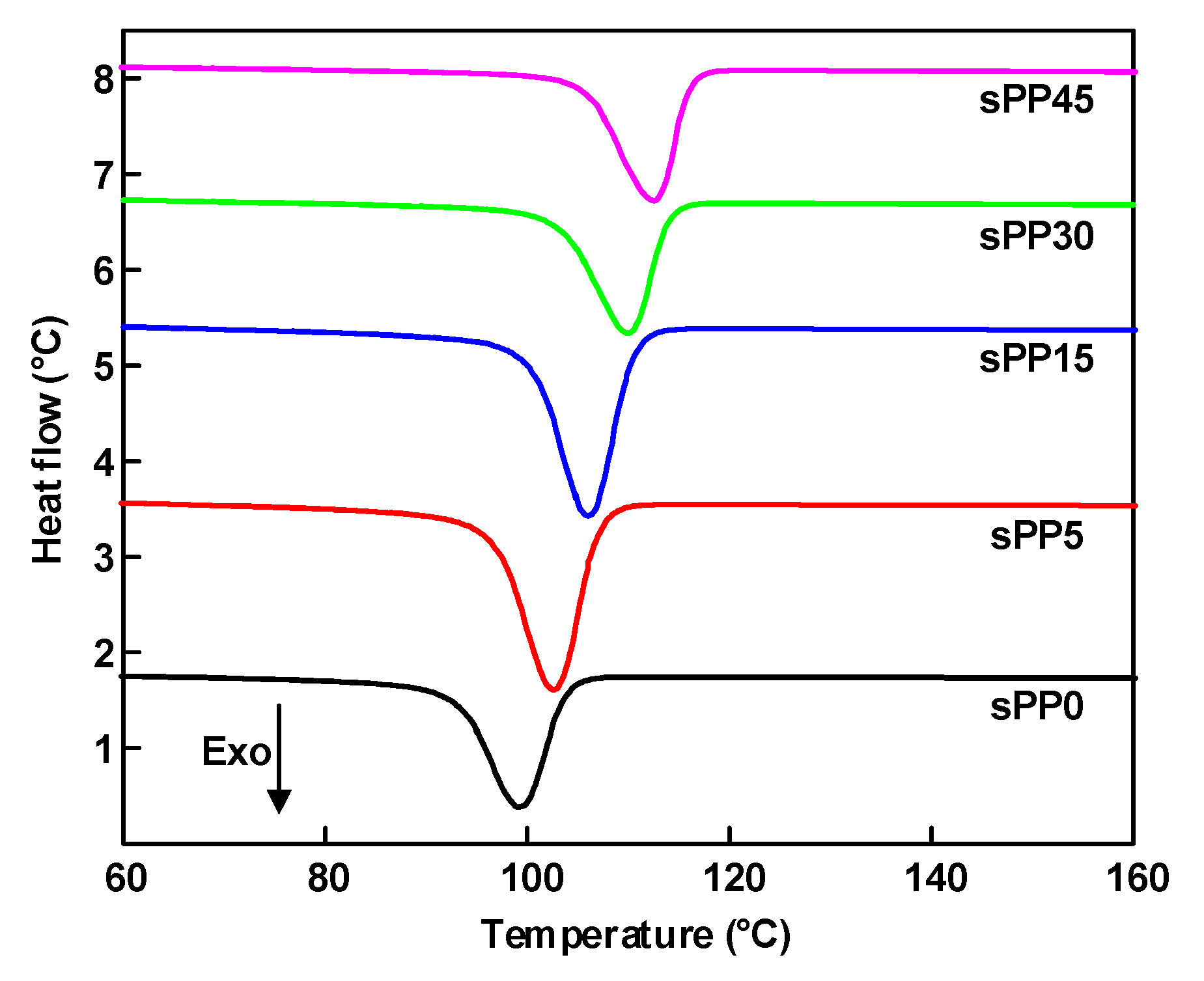

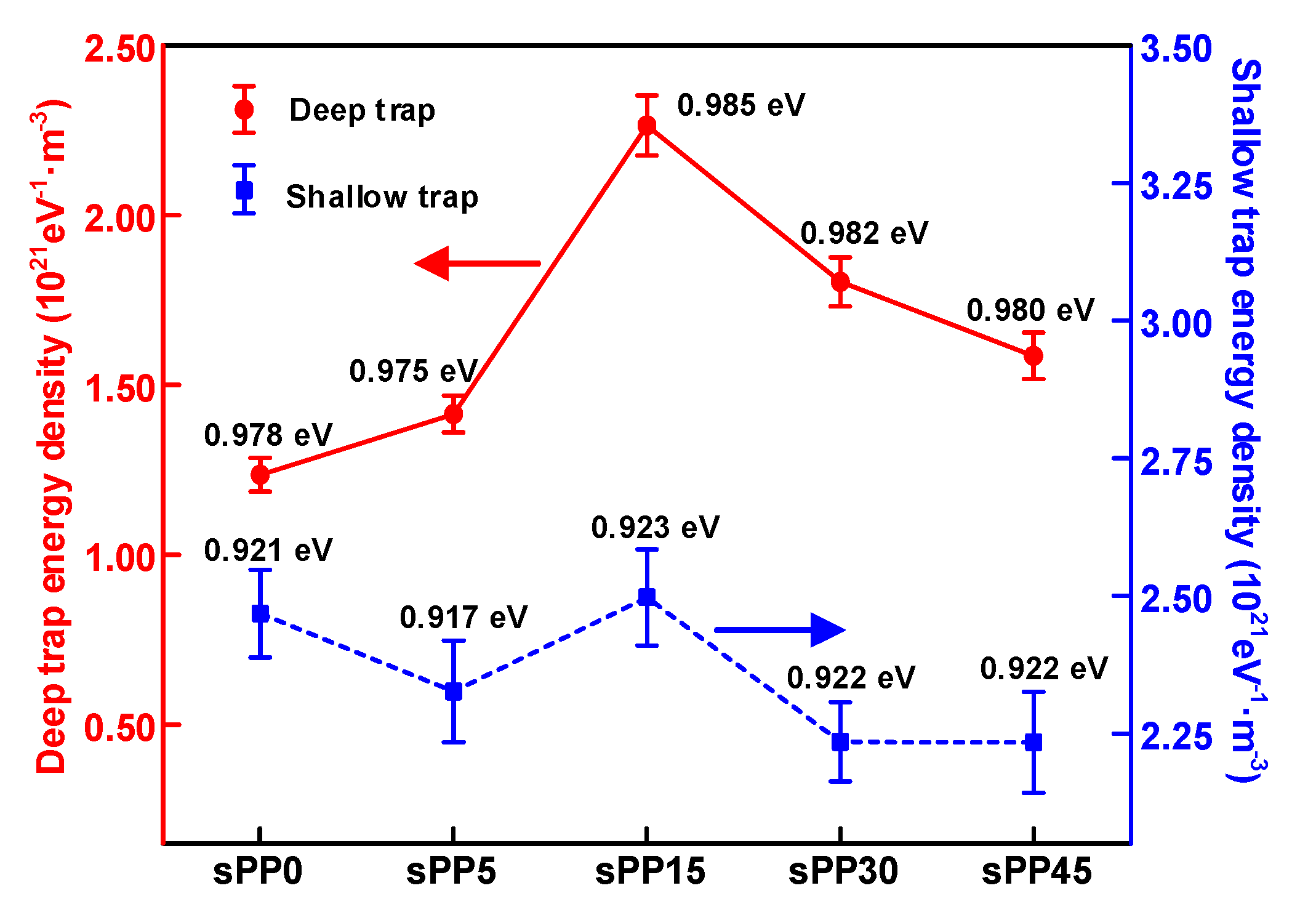
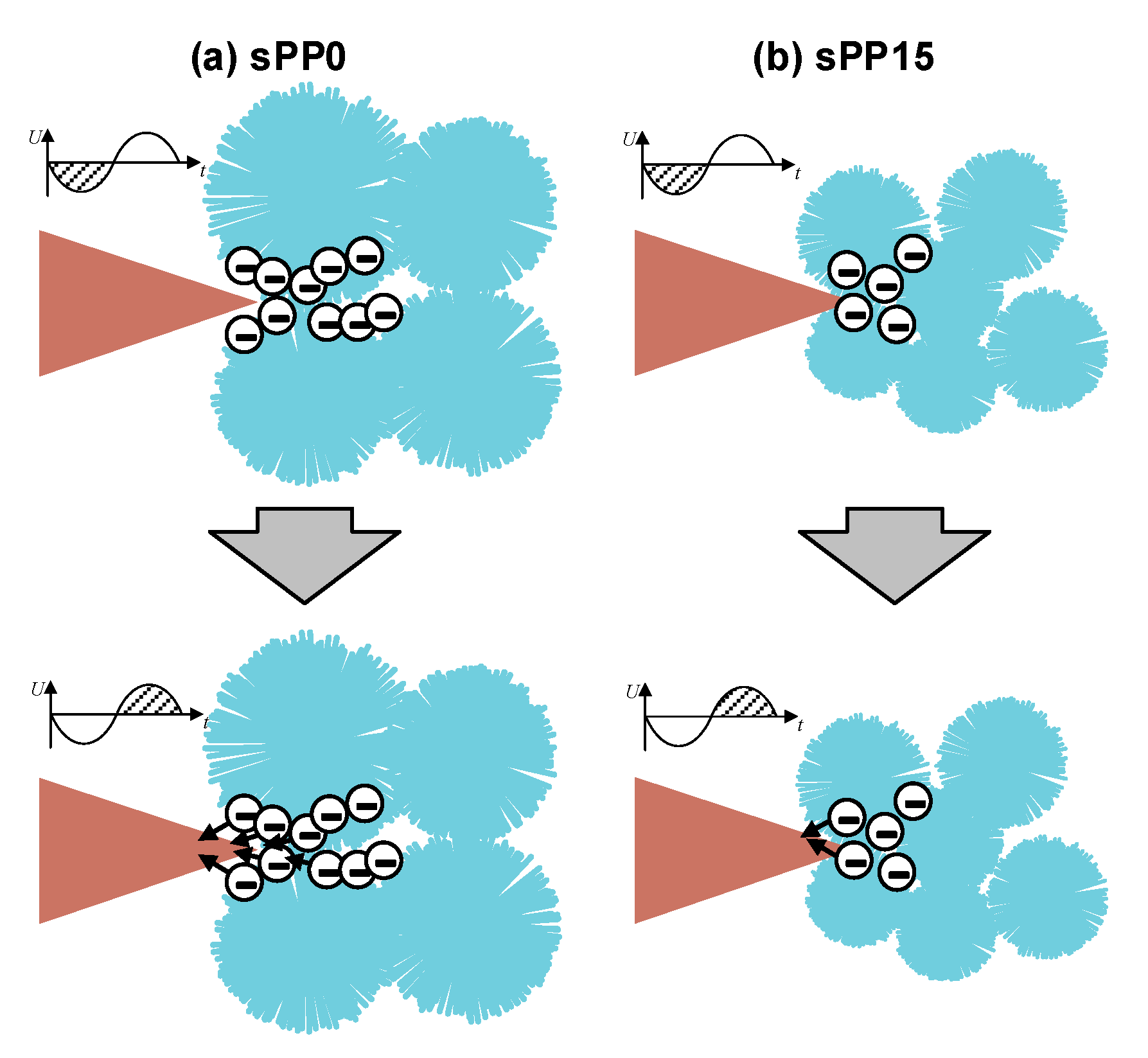
| Designation | iPP Content | sPP Content |
|---|---|---|
| sPP0 | 100 wt% | 0 wt% |
| sPP5 | 95 wt% | 5 wt% |
| sPP15 | 85 wt% | 15 wt% |
| sPP30 | 70 wt% | 30 wt% |
| sPP45 | 55 wt% | 45 wt% |
| Temperature | sPP0 | sPP5 | sPP15 | sPP30 | sPP45 |
|---|---|---|---|---|---|
| 50 °C | 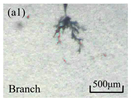 |  |  |  |  |
| 70 °C | 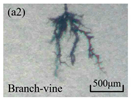 | 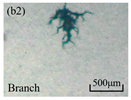 | 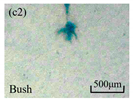 | 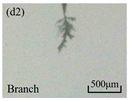 | 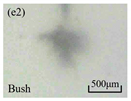 |
| 90 °C | 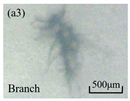 | 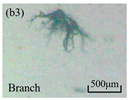 | 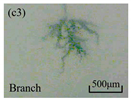 | 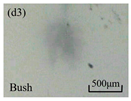 |  |
| Specimens | 5 min | 10 min | 15 min | 20 min | 40 min |
|---|---|---|---|---|---|
| sPP0 | 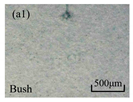 | 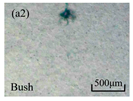 | 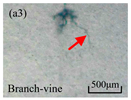 |  | 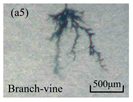 |
| sPP5 |  | 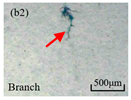 | 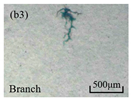 | 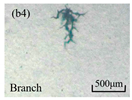 | 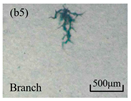 |
| sPP15 |  |  | 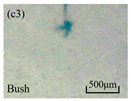 |  | 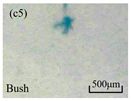 |
Publisher’s Note: MDPI stays neutral with regard to jurisdictional claims in published maps and institutional affiliations. |
© 2020 by the authors. Licensee MDPI, Basel, Switzerland. This article is an open access article distributed under the terms and conditions of the Creative Commons Attribution (CC BY) license (http://creativecommons.org/licenses/by/4.0/).
Share and Cite
Zhou, S.; Yu, F.; Yang, W.; Li, Z.; Xing, Z.; Fan, M.; Han, T.; Du, B. Effect of sPP Content on Electrical Tree Growth Characteristics in PP-Blended Cable Insulation. Materials 2020, 13, 5360. https://doi.org/10.3390/ma13235360
Zhou S, Yu F, Yang W, Li Z, Xing Z, Fan M, Han T, Du B. Effect of sPP Content on Electrical Tree Growth Characteristics in PP-Blended Cable Insulation. Materials. 2020; 13(23):5360. https://doi.org/10.3390/ma13235360
Chicago/Turabian StyleZhou, Shuofan, Fan Yu, Wei Yang, Zhonglei Li, Zhaoliang Xing, Mingsheng Fan, Tao Han, and Boxue Du. 2020. "Effect of sPP Content on Electrical Tree Growth Characteristics in PP-Blended Cable Insulation" Materials 13, no. 23: 5360. https://doi.org/10.3390/ma13235360
APA StyleZhou, S., Yu, F., Yang, W., Li, Z., Xing, Z., Fan, M., Han, T., & Du, B. (2020). Effect of sPP Content on Electrical Tree Growth Characteristics in PP-Blended Cable Insulation. Materials, 13(23), 5360. https://doi.org/10.3390/ma13235360






